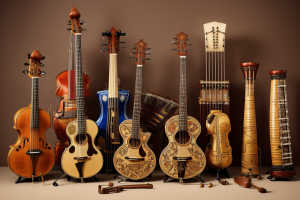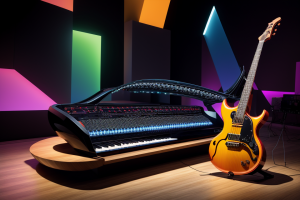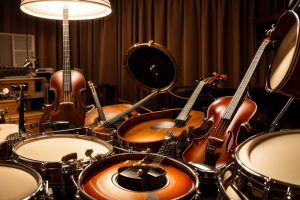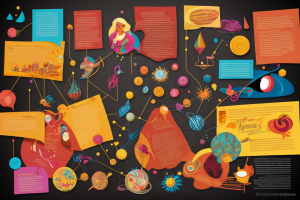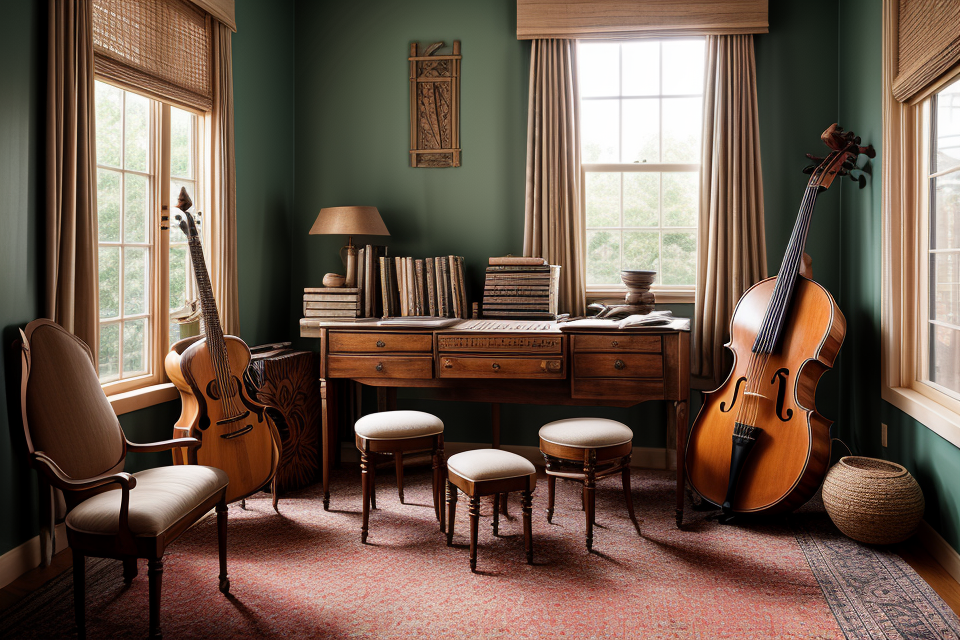
Music has been an integral part of human culture for centuries, and throughout history, various musical instruments have been developed to create captivating melodies. In this article, we will explore the four traditional musical instruments that have stood the test of time and continue to captivate audiences today. From their origin to their unique features, these instruments have played a significant role in shaping the musical landscape of the world. Join us as we embark on a journey to discover the timeless melodies of traditional musical instruments.
The Evolution of Traditional Musical Instruments
The Emergence of Stringed Instruments
The evolution of stringed instruments dates back to ancient civilizations, where musical instruments played a significant role in cultural and religious rituals. The development of stringed instruments can be traced back to the early history of human civilization, with the earliest stringed instruments discovered in the ancient Sumerian city of Ur dating back to around 3000 BCE. These early stringed instruments were primarily used in religious ceremonies and were made from wood, animal horns, and other natural materials.
One of the earliest stringed instruments was the lyre, which was popular in ancient Greece and was used in the worship of the god Apollo. The lyre was a wooden instrument with two arms and a soundbox, and it was played by plucking or strumming the strings with the fingers or a plectrum. The kithara, another stringed instrument from ancient Greece, was similar to the modern guitar and had a flat back and a round soundbox.
As civilizations advanced, so did the development of stringed instruments. In medieval Europe, the lute emerged as a popular instrument among the upper classes, and it remained popular until the 17th century. The lute was a stringed instrument with a body shaped like a pear, a neck, and a flat fingerboard. It was played by plucking or strumming the strings with the fingers or a plectrum.
Another popular stringed instrument that emerged during this time was the guitar, which has its roots in ancient civilizations such as Greece and Rome. However, the modern guitar as we know it today began to take shape in medieval Spain, where it was used in the flamenco music tradition. The guitar has since become one of the most popular stringed instruments in the world, with variations such as the classical guitar, acoustic guitar, and electric guitar.
Today, stringed instruments continue to play an important role in traditional music across the world, with many cultures still using instruments such as the sitar in India, the koto in Japan, and the banjo in the United States. These timeless melodies serve as a reminder of the rich cultural heritage of traditional music and continue to inspire musicians and listeners alike.
The Allure of Wind Instruments
Wind instruments have captivated the hearts of musicians and listeners alike for centuries. The unique ability to produce sound through the movement of air makes these instruments truly mesmerizing. In this section, we will delve into the timeless melodies of two wind instruments – the flute and the oboe.
The Flute: Whispers of the Wind
The flute is one of the oldest known instruments, with evidence of its existence dating back to over 40,000 years ago. Over the centuries, the flute has evolved into the sophisticated instrument we know today. Its unique shape and design produce a hauntingly beautiful sound that is often associated with the whispers of the wind.
The flute’s timeless melody is achieved through the precise control of airflow and finger placement. The player’s breath is directed into the instrument, causing the air to vibrate and produce sound. The flute’s high pitch and bright tone make it a staple in classical music, often featured in orchestral and chamber music compositions.
The Oboe: A Crystalline Sound of the Serenade
The oboe is another wind instrument that has captured the hearts of musicians and audiences alike. Its distinctive sound is characterized by its crystalline tones and soaring melodies. The oboe’s unique shape and construction produce a sound that is both warm and mellow, yet penetrating and expressive.
The oboe’s timeless melody is achieved through the careful balancing of air pressure and reed vibration. The player’s breath is directed into the instrument, causing the reed to vibrate and produce sound. The oboe’s rich and complex sound has made it a staple in classical music, often featured in orchestral and chamber music compositions.
Overall, wind instruments have played a significant role in the evolution of traditional music. The flute and the oboe are just two examples of the many wind instruments that have captivated musicians and audiences for centuries. Their timeless melodies continue to inspire and captivate those who hear them, making them truly ageless and enduring.
The Power of Percussion
Percussion instruments have been a cornerstone of traditional music for centuries, captivating audiences with their dynamic rhythms and infectious energy. These instruments are characterized by their ability to produce sound through the act of striking, shaking, or scraping. They have been used in a wide range of musical genres, from tribal ceremonies to classical concerts, and continue to play a vital role in modern music production.
The Drum: The Heartbeat of Music
Drums are perhaps the most ubiquitous of all percussion instruments, and for good reason. Their deep, resonant tones have the power to stir the soul and evoke emotions in a way that few other instruments can match. Whether it’s the steady beat of a snare drum or the booming bass of a kick drum, drums are essential to the rhythm section of any band or orchestra.
Drums have been used in nearly every culture throughout history, often serving as a means of communication and a way to mark important events. From ancient Egyptian temple rituals to the modern-day rock concert, drums have remained a constant presence in human culture.
The Xylophone: A Tapestry of Sound
The xylophone is another popular percussion instrument, known for its bright, tinkling tones. It is played by striking a series of wooden bars with mallets, creating a beautiful melody that is both delicate and captivating. The xylophone is often used in classical music, as well as in jazz and popular music, adding a touch of sweetness to any musical arrangement.
Like the drum, the xylophone has been around for centuries, with origins dating back to ancient civilizations such as Greece and Rome. It has since evolved into the instrument we know today, with improvements in design and construction allowing for greater versatility and expression.
In conclusion, the power of percussion instruments cannot be overstated. Their ability to evoke emotion and create a sense of rhythm is unparalleled, making them an essential component of traditional music. Whether it’s the heartbeat of a drum or the tapestry of sound created by a xylophone, these instruments continue to captivate audiences and inspire musicians of all ages and backgrounds.
Customizing Traditional Instruments for Modern Musicians
Innovative Designs and Unique Materials
Embracing Technology for Customization
- Utilizing computer-aided design (CAD) software to create precise and intricate designs
- Integrating modern materials such as carbon fiber and lightweight metals for increased durability and sustainability
Crafting Unique Instruments
- Collaborating with artisans and craftsmen to create one-of-a-kind instruments
- Experimenting with traditional techniques and unconventional materials, such as recycled or upcycled materials, to create environmentally conscious instruments
Bridging Tradition and Innovation
- Adapting traditional instrument designs to incorporate modern technologies, such as active electronics and built-in sensors, for enhanced sound quality and performance
- Fusing elements of different traditional musical instruments to create hybrid instruments that offer new timbres and tonal possibilities
By exploring innovative designs and unique materials, traditional musical instruments can be adapted to meet the needs and preferences of modern musicians while preserving their timeless melodies.
Customizing Sound and Tone
The Science of Acoustics and Sound Production
In the world of traditional musical instruments, the sound and tone are essential elements that define the timeless melodies they produce. To customize these instruments for modern musicians, it is crucial to understand the science of acoustics and sound production.
Acoustics is the study of how sound is produced, transmitted, and received. In the context of traditional musical instruments, the science of acoustics is used to design and modify the instruments to produce the desired sound and tone. For example, the shape and size of the instrument’s body, the type of wood used, and the thickness of the strings can all affect the sound and tone produced by the instrument.
In addition to the physical properties of the instrument, the player’s technique and playing style also play a significant role in determining the sound and tone. For instance, the way a musician holds the instrument, the pressure applied to the strings, and the speed at which the strings are struck can all impact the sound and tone produced.
Personalizing the Instrument’s Voice
Personalizing the instrument’s voice is another essential aspect of customizing sound and tone. This involves making adjustments to the instrument to suit the musician’s playing style and preferences. For example, a musician may prefer a brighter or darker sound, and adjustments can be made to the instrument to achieve this.
One way to personalize the instrument’s voice is by adjusting the strings. The gauge, material, and tuning of the strings can all affect the sound and tone produced by the instrument. A thicker string, for instance, will produce a darker sound than a thinner string. Similarly, changing the tuning of the strings can also alter the sound and tone.
Another way to personalize the instrument’s voice is by adding accessories such as pickups, amplifiers, and effects pedals. These accessories can enhance the instrument’s sound and tone, allowing the musician to achieve a wide range of timbres and textures.
In conclusion, customizing the sound and tone of traditional musical instruments is a crucial aspect of tailoring them to modern musicians’ needs. By understanding the science of acoustics and sound production and personalizing the instrument’s voice, musicians can unlock the full potential of these timeless instruments and create unique and memorable melodies.
Embracing Tradition in Today’s Music Scene
Traditional Instruments in Modern Music Genres
Jazz and Blues: The Soulful Sound of Tradition
In today’s music scene, traditional instruments have found their way into various modern music genres, breathing new life into these timeless melodies. Jazz and blues, two of the most popular music genres, have embraced traditional instruments to create a unique and soulful sound that captivates audiences.
Jazz and Blues: The Soulful Sound of Tradition
Jazz and blues, two genres rooted in African-American culture, have always incorporated traditional instruments into their music. The blues, for example, makes use of the guitar, harmonica, and piano, while jazz incorporates the trumpet, saxophone, and clarinet. These instruments have played a crucial role in shaping the distinctive sounds of jazz and blues, giving them their raw and soulful qualities.
However, in recent years, jazz and blues musicians have started to experiment with traditional instruments from other cultures, such as the oud, sitar, and dulcimer. This fusion of different musical traditions has given rise to a new sound that blends the soulful melodies of the blues with the intricate rhythms of jazz, creating a unique and captivating sound that is both modern and traditional.
One example of this fusion can be seen in the work of jazz and blues musicians like John Lee Hooker Jr., who has incorporated traditional instruments like the oud and sitar into his music, creating a unique sound that pays homage to his father’s blues roots while also pushing the boundaries of modern jazz.
In conclusion, the use of traditional instruments in modern music genres like jazz and blues has helped to create a unique and soulful sound that is both timeless and modern. By embracing tradition, musicians can create a distinctive sound that captivates audiences and pays homage to the rich cultural heritage of music.
Collaborations and Fusion: Blending Traditional and Modern Instruments
The Joy of Cross-Genre Performance
The fusion of traditional and modern musical instruments has opened up a world of possibilities for musicians and listeners alike. The unique timbres and textures of traditional instruments can add depth and complexity to modern music, while the innovative technology and versatility of modern instruments can breathe new life into traditional melodies. This blending of sounds allows for a more diverse and dynamic musical landscape, encouraging artists to push boundaries and experiment with different styles.
One of the most exciting aspects of cross-genre performance is the opportunity to explore the contrast between different musical traditions. For example, the haunting melodies of a classical string quartet can be paired with the driving rhythms of a traditional African drum ensemble, creating a soundscape that is both familiar and entirely new. By combining the strengths of different musical traditions, artists can create a sense of unity and shared cultural experience that transcends language and geographical barriers.
The Art of Musical Synergy
Collaboration between traditional and modern instruments can lead to unexpected and inspiring musical discoveries. For instance, the ethereal tones of a Tibetan singing bowl can be amplified and manipulated through electronic effects, creating a haunting and otherworldly sound that is both ancient and futuristic. This blending of sounds allows for a more immersive and emotional musical experience, as listeners are drawn into a world of contrasts and contradictions.
Moreover, the process of blending traditional and modern instruments often involves a great deal of experimentation and improvisation. Musicians must learn to navigate the unique challenges and opportunities presented by each instrument, and to find ways to complement and enhance one another’s playing. This creative process can lead to a deeper understanding and appreciation of both the traditional and modern instruments, as well as a greater sense of connection between the musicians themselves.
Ultimately, the fusion of traditional and modern musical instruments represents a powerful force in today’s music scene. By embracing the unique timbres and textures of these instruments, artists can create a sense of timelessness and continuity that transcends cultural and historical boundaries. Through collaboration and experimentation, musicians can explore new sonic landscapes and create a more diverse and dynamic musical world for all to enjoy.
FAQs
1. What are the four traditional musical instruments?
The four traditional musical instruments are the piano, violin, cello, and guitar.
2. What is the history of these instruments?
The piano has been around since the early 18th century, the violin has been played since the 15th century, the cello was invented in the late 16th century, and the guitar has been around for over 4,000 years.
3. How are these instruments played?
The piano is played by pressing keys that strike strings, the violin is played by bowing strings, the cello is played by holding the instrument and using a bow or plucking the strings, and the guitar is played by strumming or plucking strings.
4. What kind of music is typically played on these instruments?
All four instruments are commonly used to play a wide variety of music, including classical, pop, rock, and jazz.
5. Are these instruments difficult to learn?
It depends on the individual and the amount of time and effort put into learning the instrument. With dedication and practice, anyone can learn to play these instruments.
6. How do I get started with learning one of these instruments?
There are many resources available for learning to play traditional musical instruments, including private lessons, group classes, and online tutorials. It’s important to find an approach that works best for you and to practice regularly.
